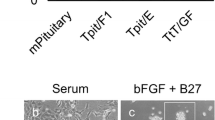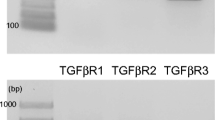Abstract
A new cell line (TtT/GF) established from a murine pituitary thyrotropic tumor having characteristics similar to those of pituitary folliculo-stellate cell (FS cell) was implanted into nude mice together with cells from a rat pituitary somatotrophic tumor cell line (MtT/S) to determine whether the former enhances pituitary tumor growth. For as long as 2-3 mo after implantation, MtT/S cells implanted either alone or together with fibroblasts formed either no tumors or only very small tumors in the nude mice. In contrast all of the nude mice that had received MtT/S cells implanted together with TtT/GF cells developed large tumors. Furthermore, the mice bearing the MtT/S and TtT/GF implants showed a significantly higher body weight and serum growth hormone level than those bearing only MtT/S cells or a combination of MtT/S cells and fibroblasts. The TtT/GF cell line itself had no tumorigenicity during the experimental period. Therefore, the TtT/GF cell line as a model of FS cells enhanced pituitary endocrine cell tumor formation. Additionally, immunocytochemistry showed that TtT/GF cells positive for glial fibrillary acidic protein (GFAP) or S-100 protein were present in the parenchymatous tissue elements or connective tissue surrounding the tumor nests. In the parenchymatous tissue, the TtT/GF cells exhibited a stellate appearance and surrounded neighboring tumor cells with their long cell processes. These results suggest that TtT/GF cells can serve as a model for pituitary FS cells, and are capable of stimulating pituitary tumor growth either by modifying the microenvironment or producing growth factors.
Similar content being viewed by others
References
Farquhar MG. Corticotrophs of the rat adenohypophysis as revealed by electron microscopy. Anat Rec 127: 291, 1957 (abstract).
Rinehart JF, Farquhar MG. Electron microscopic studies of the anterior pituitary gland. J Histochem Cytochem 1: 93–113, 1953.
Yoshimura F, Soji T, Sato S, Yokoyama M. Development and differentiation of rat pituitary follicular cells under normal and some experimental conditions with special reference to and interpretation of the renewal cell system. Endocrinol Jpn 24: 435–449, 1977.
Stokreef JC, Reifel CW, Shin SH. A possible phagocytic role for folliculo-stellate cells of anterior pituitary following estrogen withdrawal from primed male rats. Cell Tissue Res 243: 255–261, 1986.
Ferrara N, Fujii DK, Goldsmith PC, Widdicombe JH, Weiner RI. Transport epithelial characteristics of cultured bovine pituitary follicular cells. Am J Physiol 252 (Endocrinol Metab 15):E304-E312, 1987.
Ferrara N, Schweigereer L, Neufelo G, Mitchell R, Gospodarowicz D. Pituitary follicular cells produce basic fibroblast growth factor. Proc Natl Acad Sci USA 84: 5773–5777, 1987.
Gospodarowicz D, Lau K. Pituitary follicular cells secrete both vascular endothelial growth factor and follistatin. Biochem Biophys Res Commun 165: 292–298, 1987.
Vankelcom H, Carmeliet P, Van Damme J, Billiau A, Denef C. Production of interleukin-6 by folliculo-stellate cells of the anterior pituitary gland in a histiotypic cell aggregate culture system. Neuroendocrinology 49: 102–106, 1989.
Vankelecom H, Matthys P, Damme JV, Heremans H, Billiau A, Deneff C. Immunocytochemical evidence that S-100-positive cells of the mouse anterior pituitary contain interleukin-6 immunoreactivity. J Histochem Cytochem 41: 151–156, 1993.
Höfler H, Walter GF, Denk H. Immunohistochemistry of folliculo-stellate cells in normal human adenohypophyses and in pituitary adenomas. Acta Neuropathol 65: 35–40, 1984.
Iwaki T, Kondo A, Takeshita I, Nakagaki H, Kitamura K, Tateishi J. Proliferation potential of folliculo-stellate cells in human pituitary adenomas. Acta Neuropathol 71: 233–242, 1986.
Schechter J., Ahmad N., Weiner R. Activation of anterior pituitary folliculo-stellate cells in the formation of estrogen-induced prolactinsecreting tumors. Neuroendocrinology 48: 569–576, 1988.
Cocchia D, Miani N. Immunocytochemical localization of the brain-specific S-100 protein in the pituitary gland of adult rat. J Neurocytol 9: 771–782, 1980.
Nakajima T, Yamaguchi H, Takahashi K. S-100 protein in folliculo-stellate cells of the rat pituitary anterior lobe. Brain Res 191: 523–531, 1980.
Velasco ME, Roessmann U, Gambetti P. The presence of glial fibrillary acidic protein in the human pituitary gland. J Neuropathol Exp Neurol 41: 150–163, 1982.
Inoue K, Matsumoto H, Koyama C, Shibata K, Nakazato Y, Ito A. Establishment of a folliculostellate-like cell line from a murine thyrotropic pituitary tumor. Endocrinology 131: 3110–3116, 1992.
Matsumoto H, Koyama C, Sawada T, Koike K, Hirota K, Miyake A, Arimura A, Inoue K. Pituitary folliculo-stellate-like cell line (TtT/ GF) responds to novel hypophysiotropic peptide (PACAP), showing increased cAMP and IL-6 secretion and cell proliferation. Endocrinology 133: 2150–2155, 1993.
Inoue K, Hattori MA, Sakai T, Inukai S, Fujimoto N, Ito A. Establishment of a series of pituitary clonal cell lines differing in morphology, hormone secretion, and response to estrogen. Endocrinology 126: 2313–2320, 1990.
Fujimoto N, Watanabe H, Ito A, Inoue K. Estrogen receptor levels and tumor growth in a series of pituitary clonal cells. Jpn J Cancer Res 82: 1436–1441, 1991.
Nakazato Y, Ishizeki J, Takahashi K, Yamaguchi H, Kamei T, Mori T Localization of S-100 protein and glial fibrillary acidic protein-related antigen in pleomorphic adenoma of the salivary glands. Lab Invest 46: 621–626, 1982.
Alberts W, Carmeliet P, Denef C. New perspectives in the function of pituitary folliculostellate cells. Mol Cell Endocrinol 71: 73–81, 1990.
Spangelo BL, Isakson PC, Macleod RM. Production of interleukin-6 by anterior pituitary cells is stimulated by increased intracellular adenosine 3’, 5’-monophosphate and vasoactive intestinal peptide. Endocrinology 127: 403–409, 1990.
Tatsuno I, Somogyvari-Vigh A, Mizuno K, Gottschall PE, Hidaka H, Arimura A. Neuropeptide regulation of interleukin-6 production from the pituitary: stimulation by pituitary adenylate cyclase activating polypeptide and calcitonin gene-related peptide. Endocrinology 29: 1797–1804, 1991.
Stetler-Stevenson WG, Krutzsch HC, Liotta LA. Tissue inhibitor of metalloproteinase (TIMP-2). J Biol Chem 264: 17, 374-17, 378, 1989.
Matsumoto H, Ishibashi Y, Ohtaki T, Hasegawa Y, Koyama C, Inoue K. Newly established murine pituitary folliculo-stellate-like cell line (TtT/GF) secretes potent pituitary glandular cell survival factors, one of which corresponds to metalloproteinase inhibitor. Biochem Biophys Res Commun 194: 909–915, 1993.
Arzt E, Buric R, Stelzer G, Stalla J, Sauer J, Renner U, Stalla GK. Interleukin involvement in anterior pituitary cell growth regulation: effects of IL-2 and IL-6. Endocrinology 132: 459–467, 1993.
Koike K, Sawada T, Kanda Y, Ikegami H, Jikihara H, Hirota K, Tasaka K, Nishizaki T, Miyake A, Tanizawa O. Interleukin-6 stimulates cell proliferation of rat pituitary clonal cell lines in vitro. Abstract of 3rd International Pituitary Congress, Los Angeles, CA, 1993.
Author information
Authors and Affiliations
Rights and permissions
About this article
Cite this article
Koyama, C., Matsumoto, H., Sakai, T. et al. Pituitary folliculo-stellate-like cells stimulate somatotropic pituitary tumor growth in nude mice. Endocr Pathol 6, 67–75 (1995). https://doi.org/10.1007/BF02914990
Issue Date:
DOI: https://doi.org/10.1007/BF02914990




